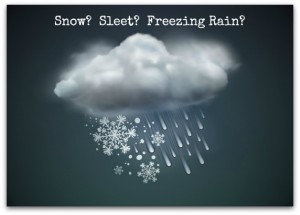Uncle John knows pretty much everything—and if he doesn’t, he heads his massive research library, or puts one of his many associates on the case. So go ahead: In the comments below, ask Uncle John anything. (And if we answer your question sometime, we’ll send you a free book!)
What’s the difference between snow, sleet, and freezing rain?
 All are forms of precipitation, and all involve the temperature being cold enough for these little balls of ice, or very, cold water, to fall from the sky. But how do you tell them apart?
All are forms of precipitation, and all involve the temperature being cold enough for these little balls of ice, or very, cold water, to fall from the sky. But how do you tell them apart?
All start as precipitation, or water, falling through the atmosphere on its way to the ground. There are many different levels of the atmosphere, and there can be extreme shifts in temperature and pressure along the way that cause that precipitation to change form. Rain can begin as snow, falling from a cold atmospheric level, but by the time it’s reached the surface, where the temperature is warmer, it may melt back into rain.
Snow is formed in clouds that are below freezing temperature. As this precipitation falls through the atmosphere, and if the air remains at 32 degrees F or lower, it will remain a snowflake for its entire descent. But if it’s too cold in the atmosphere, that can dry out the air, resulting in less airborne water vapor. If precipitation starts as snow, warms up, and then refreezes, it becomes little pellets called sleet.
That’s different from freezing rain. Sleet forms from a small warm pocket; freezing rain occurs after the precipitation hits a larger, thicker pocket of warm air. That warm pocket causes some melting to happen. But upon hitting another cool air zone, it cools a little, but without freezing it. It turns to ice when it hits the below-freezing surface temperature of the ground.
Looking for more science trivia? Check out Uncle John’s Bathroom Reader Plunges into the Universe.







